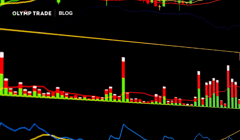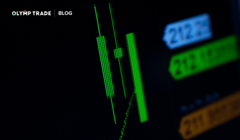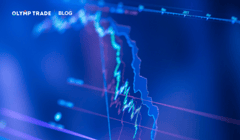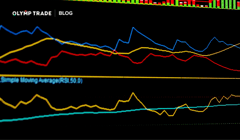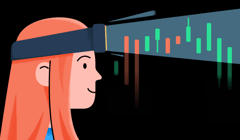
World currency symbols indicate denominated money from countries around the world in a word. Most new traders know the top world currency symbols like the US dollar ($) or the euro (€). However, there are many other symbols that traders should know before expanding their trading portfolio.
On the other hand, recognizing world currency symbols is extremely useful when traveling abroad or purchasing goods from other countries. In the following section, we will explore the global currency system in depth, then list all the world currency symbols we think you should bookmark.
Contents:
- What is currency?
- How many currencies are there in the world?
- The design of world currency symbols
- World currency symbols in the financial market
- Currency symbols on Olymp Trade
- Key world currency symbols
- Final thoughts
Interact with the underlined words and green dots to get additional details and explanations.
Additional context for the visuals.
Explanations and definitions of terms.
What is currency?
Used as a means of exchange, currency is money that a country or group of countries use. Currencies are typically standardized into bank notes and metal coins, but in today’s technological age and with the Web3 wave coming, currencies are increasingly migrating to online, digital formats. Some, like cryptocurrencies, are solely online, but are not owned or produced by any country.
The issuing state works with its federal or reserve bank to determine how much of its national currency to print and how much will be in circulation. Moreover, a currency’s strength depends on a multitude of factors, including domestic and foreign demand, interest rates, inflation, political stability and trade relations, which all play into how much it costs against other global currencies on the Forex market.
How many currencies are there in the world?
While not entirely reflective of the total number of currencies in circulation today, there are 180 legal currencies in circulation in United Nations member countries. Among these, 50 have their value pegged to another currency, while the remaining 130 are independent.
Some countries accept more than one currency as legal tender, particularly in times of political instability or reform. Cyprus, for example, accepts both the euro and Turkish lira as payment for any transaction, and Cuba has a currency pegged to the US dollar alongside its national currency.
The reason why some countries have a currency pegged to the US dollar is because it is the world’s reserve currency, meaning that in place of the gold standard, countries are now depositing and withdrawing US dollars in order to print their local currencies, among other financial activities.
The design of world currency symbols
There is a graphical shorthand symbol for just about every global currency. Some of these symbols have been in use for thousands of years.
The British pound sterling (£) is known as the oldest currency in the world, as it came into use in the year 775 AD. The pound’s symbol came from the Roman alphabetical letter “L” for “Libra,” the standard unit of weight in the Roman empire, which is equivalent to one pound of silver.
The symbol of the US dollar ($) came from the old Spanish-American peso back in the 17th century. It began as the letter “P” being superimposed on the letter “S” as shorthand for “Peso de ocho reales,” which means “piece of eight.”
The symbol for the euro (€) sign came from the Greek epsilon (ϵ), which looks like the English letter “E” for Europe and is written with two horizontal lines to signify stability.
In India, the Rupee sign (₹) came from a blend of the Devanagari “र” and the Roman letter “R” to signify “Rupiah.”
On the other hand, many countries have adopted the currency symbol of others. Most notably, Australia, Hong Kong, Canada and Singapore, among other countries, have adopted the dollar sign and denomination for their own national currencies, while Japanese yen and Chinese yuan share the (¥) symbol.
World currency symbols in the financial market
In financial market trading, currency symbols play an important role, as they help traders understand the associated countries’ currency.
The Forex market is a place to buy and sell currency pairs and make money online, where each currency has a unique, three-letter code that is typically an abbreviation of the name. For example, the US dollar–Japanese yen pair is named USD/JPY, and can be found on Olymp Trade’s currency pairs list under Assets in the left window of the platform.

On Olymp Trade, apart from Forex mode, you can get the most out of trading currency pairs using Fixed Time Trades mode.
Currency symbols on Olymp Trade
In this section, we will see the full name, ISO currency code and symbol of currencies available on Olymp Trade:
| Name | Short Form | Symbol |
|---|---|---|
| US dollar | USD | $ |
| Euro | EUR | € |
| Pound sterling | GBP | £ |
| Australian dollar | AUD | $ |
| Japanese yen | JPY | ¥ |
| New Zealand dollar | NZD | $ |
| Canadian dollar | CAD | $ |
| Swiss franc | CHF | CHF |
Key world currency symbols
Here is our list of the money symbols around the world that we believe are worth keeping an eye on:
| Country | Currency name | Currency code | Symbol |
|---|---|---|---|
| Albania | Albanian lek | ALL | L |
| Argentina | Argentine peso | ARS | $ |
| Armenia | Armenian dram | AMD | ֏ |
| Australia | Australian dollar | AUD | $ |
| Azerbaijan | Azerbaijani manat | AZN | ₼ |
| Belarus | Belarusian rubel | BYN | Rbl |
| Bolivia | Boliviano | BOB | Bs. |
| Botswana | Botswana pula | BWP | P |
| Bulgaria | Bulgarian lev | BGN | Лв. |
| Brazil | Brazilian real | BRL | R$ |
| Cambodia | Cambodian riel | KHR | ៛ |
| Canada | Canadian dollar | CAD | $ |
| China | Chinese yuan (Renminbi) | CNY | ¥ |
| Colombia | Colombian peso | COP | $ |
| Costa Rica | Costa Rican colón | CRC | ₡ |
| Croatia | Croatian kuna | HRK | kn |
| Cuba | Cuban peso | CUP | $ |
| Czech Republic | Czech koruna | CZK | Kč |
| Denmark | Danish krone | DKK | kr. |
| Dominican Republic | Dominican peso | DOP | $ |
| Egypt | Egyptian pound | EGP | E£ |
| El Salvador | El Salvador colón | SVC | ₡ |
| European Union | Euro | EUR | € |
| Fiji | Fijian dollar | FJD | FJ$ |
| Ghana | Ghanaian cedi | GHS | GH¢ |
| Guatemala | Guatemalan quetzal | GTQ | Q |
| Guinea | Guinean franc | GNF | FG |
| Guyana | Guyanese dollar | GYD | $ |
| Hong Kong | Hong Kong dollar | HKD | $ |
| Honduras | Honduran lempira | HNL | L |
| Hungary | Hungarian forint | HUF | Ft |
| India | Indian rupee | INR | ₹ |
| Iceland | Icelandic króna | ISK | kr |
| Iran | Iranian rial | IRR | ﷼ |
| Israel | Israeli shekel | ILS | ₪ |
| Japan | Japanese yen | JPY | ¥ |
| Kazakhstan | Kazakhstani tenge | KZT | ₸ |
| Kenya | Kenyan shilling | KES | /= |
| Kuwait | Kuwaiti dinar | KWD | د.ك |
| Malawi | Malawian kwacha | MWK | MK |
| Malaysia | Malaysian ringgit | MYR | RM |
| Mexico | Mexican peso | MXN | $ |
| Morocco | Moroccan dirham | MAD | MAD |
| Namibia | Namibian dollar | NAD | N$ |
| Nepal | Nepalese rupee | NPR | Rs. |
| New Zealand | New Zealand dollar | NZD | $ |
| Norway | Norwegian krone | NOK | kr |
| Oman | Omani rial | OMR | ر.ع. |
| Pakistan | Pakistani rupee | PKR | Rs |
| Peru | Sol | PEN | S/ |
| Philippines | Philippine peso | PHP | ₱ |
| Poland | Polish złoty | PLN | zł |
| Qatar | Qatari riyal | QAR | QR |
| Romania | Romanian leu | RON | L |
| Russia | Russian ruble | RUB | ₽ |
| Saudi Arabia | Saudi riyal | SAR | ر.س |
| Serbia | Serbian dinar | RSD | din |
| Seychelles | Seychellois rupee | SCR | ₨ |
| Singapore | Singapore dollar | SGD | $ |
| Solomon Islands | Solomon Islands dollar | SBD | Si$ |
| Somalia | Somali shilling | SOS | Sh.so |
| South Africa | South African rand | ZAR | R |
| Sri Lanka | Sri Lankan rupee | LKR | Re |
| Sweden | Swedish krona | SEK | kr |
| Switzerland | Swiss franc | CHF | CHf. |
| Syria | Syrian pound | SYP | £S |
| Taiwan | New Taiwan dollar | TWD | NT$ |
| Thailand | Thai baht | THB | ฿ |
| Trinidad and Tobago | Trinidad and Tobago dollar | TTD | TT$ |
| Turkey | Turkish lira | TRY | ₺ |
| Ukraine | Ukrainian hryvnia | UAH | ₴ |
| United Kingdom | Pound sterling | GBP | £ |
| United States | United States dollar | USD | $ |
| Uruguay | Uruguayan Peso | UYU | $ |
| Uzbekistan | Uzbekistani sum | UZS | so’m |
| Venezuela | Venezuelan bolívar | VED | Bs. |
| Vietnam | Vietnamese dong | VND | ₫ |
| Yemen | Yemeni rial | YER | ﷼ |
| Zimbabwe | Zimbabwean dollar | ZWL | $ |
Final thoughts
Currency symbols and their associated codes are important tools for businesses and investors engaging in international transactions. The list above might help you to find your desired country and its currency symbol.
Knowing your target currency’s symbol and code is a primary requirement for trading, particularly in Forex. The Forex market is truly massive, so there’s a lot to learn. We recommend getting familiar with the major trading terms and how to trade in Forex for beginners, and for those more seasoned, our articles on oscillators and risk management are sure to enhance your current strategy.
The articles listed here only scratch the surface of the free educational resources available on Olymp Trade Blog. It’s our aim to get you trading like a pro, so you can take control of your financial future and become a force to be reckoned with on the markets.
Trade on CurrenciesRisk warning: The contents of this article do not constitute investment advice, and you bear sole responsibility for your trading activity and/or trading results.
The next generation of the internet and part of the incoming Fourth Industrial Revolution. It is largely based on blockchain technology and supports self-sovereign finance and identity.
A monetary system in which a currency is pegged to a fixed amount of gold.


